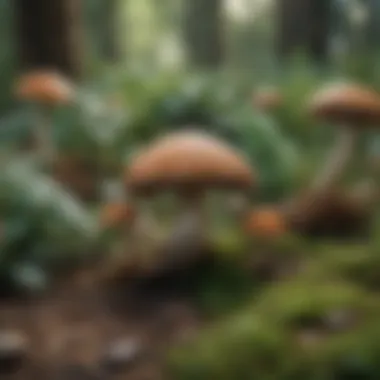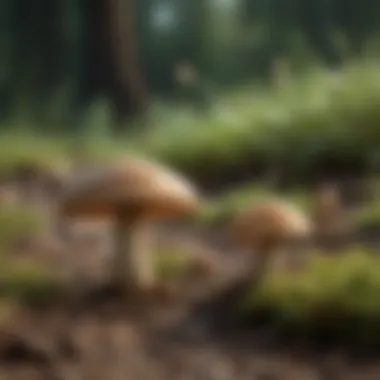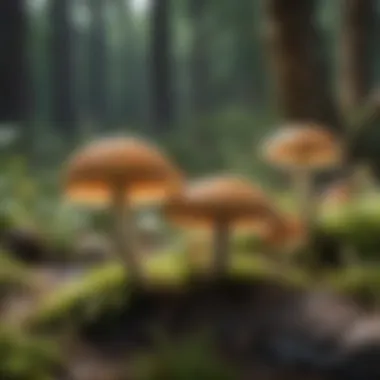Key Factors Leading to Mushroom Decline in Your Yard


Intro
Mushrooms, those curious fungi, often dot the landscape of our yards, bringing a touch of life and vibrancy. However, they are not invincible. A host of factors can lead to their demise, creating challenges for those who seek to maintain a flourishing natural habitat at home. To nurture a healthy population of mushrooms, it's essential to recognize what harms them. In this exploration, we shall delve into the components that can kill mushrooms in your yard. The insights provided here will enhance your understanding and inform your management practices.
Environmental Factors
The outdoors can be a fickle friend for mushrooms. Various environmental conditions play a role in their survival, and understanding these can be the key to keeping them thriving in your yard.
Temperature Variations
Mushrooms are quite sensitive to temperature, and extreme heat or cold can be detrimental.
- High temperatures can dehydrate the mushroom caps, causing them to wither and die.
- Conversely, unexpected freezes may freeze the water within the cells of mushrooms, leading to cell rupture, which renders them inedible.
Having the right microclimate in your yard can promote a favorable environment. Ensure shaded areas are kept intact to buffer against excessive sun exposure.
Soil Conditions
The soil is the lifeblood of mushrooms. Poor soil quality can lead to a decline in mushroom populations.
- pH levels: Most mushrooms prefer slightly acidic to neutral soil, around 5.5 to 7.0. Too much alkalinity can hinder their growth.
- Nutrient Deficiency: A soil lacking essential nutrients such as nitrogen, phosphorus, and potassium can result in a barren fungal landscape.
- Waterlogged conditions can also spell trouble, as mushrooms require a good balance of moisture but can drown in standing water.
Biological Interactions
Mushrooms do not thrive in isolation; their existence is intertwined with other organisms.
Symbiotic Relationships
Many mushrooms engage in mycorrhizal relationships with plant roots, providing each other with nutrients vital for growth. Disrupting these delicate associations through over-fertilization or introducing chemicals can lead to mushroom decline.
Competition
In the garden, mushrooms must vie for resources. Certain plants or fungi can outcompete mushrooms for nutrients and space, leading to their gradual disappearance over time. Be aware of invasive species that might choke out these lesser-known fungi.
Human Practices
Our actions can often inadvertently disrupt mushroom growth.
Lawn Maintenance
The manner in which lawns are maintained can significantly affect mushrooms. Frequent mowing and aerating can remove their fruiting bodies and disrupt mycelium growth. Here are a few practices to consider:
- Minimal Poaching: Avoid uprooting mushrooms when tending to your garden.
- Natural Mulching: Use organic materials that provide moisture and shelter instead of synthetic alternatives.
Chemical Usage
The application of herbicides and pesticides is a double-edged sword. While intended to target weeds or pests, these chemicals can also eradicate beneficial fungi essential for a balanced ecosystem. It’s critical to read labels and practice integrated pest management to mitigate unintended harm.
End
By comprehending the various factors that contribute to the decline of mushrooms, yard owners can take informed steps towards preserving these fascinating organisms. The interplay of environmental conditions, biological interactions, and human actions shapes the mushroom population in any given area. By protecting these unique species, homeowners can foster resilience in their gardens, creating an enduring tableau of life.


"Mushrooms are not just a garnish, but a crucial part of the ecosystem that deserves our protection and respect."
As you embark on this journey of understanding, consider the nuances of nature that often go unnoticed. A small effort in caring for mushrooms can yield magnificent returns in the form of a lush, diverse yard.
Prologue to Mushrooms in Yards
Mushrooms add a distinctive charisma to yards, transforming ordinary spaces into captivating ecosystems. However, their presence isn’t just about aesthetics; mushrooms play pivotal roles in the functioning of the environment. Understanding the significance of mushrooms in your yard helps to recognize both their benefits and the factors that may threaten their growth.
The Role of Mushrooms in Ecosystems
Mushrooms are not merely the pretty hats that spring up on damp lawns. They are essential players in the broader ecological theater. These fungi decompose organic matter, turning decay into nutrients that enrich soil. In this way, they form what ecologists call a "mycorrhizal association" with trees. This symbiosis extends roots and enhances water and nutrient uptake, supporting plant health.
Additionally, mushrooms aid in carbon cycling, playing a role in sequestering carbon and contributing to soil fertility. So, when they thrive, ecosystems flourish.
They also serve as food for wildlife, from insects to larger mammals. By providing sustenance, mushrooms contribute to the food web, underscoring their vital position in local biodiversity.
In essence, understanding mushrooms' role furnishes a new lens through which to appreciate not just their beauty, but their utility within the ecological tapestry of a yard.
Why Homeowners Might Want to Remove Mushrooms
Despite the ecological benefits, homeowners often find themselves in a quandary when it comes to mushrooms. One of the most pressing reasons for removal is the concern over toxicity. Some mushrooms can be dangerously poisonous, presenting a risk particularly to pets and children. The fear of potential accidents sometimes casts a shadow over the diverse charm fungi can bring.
Moreover, homeowners frequently associate mushrooms with poor lawn health or excess moisture. A yard peppered with mushrooms may signal underlying issues like overly compacted soil or a drainage problem. These visible reminders of imbalance prompt action to restore the lawn's condition.
In some communities, aesthetic preferences guide the decision to eliminate mushrooms. A sprawl of fungi may clash visually with manicured landscaping, leading to their removal simply for appearances' sake.
Thus, while mushrooms play an integral part in ecosystems, the combination of safety concerns, maintenance issues, and aesthetic choices often drives homeowners to take action against them.
Environmental Conditions Affecting Mushroom Growth
When it comes to mushrooms thriving in your yard, environmental conditions play a critical role. The delicate balance of soil, moisture, and temperature must align favorably for fungi to flourish. Understanding these factors isn't just about appreciating fungi; it's also about maintaining a vibrant ecosystem. Homeowners often overlook the small details that can make or break their mushroom growth, missing out on the potential beauty and benefits these organisms can bring.
Soil Composition and Quality
Importance of Nutrient-Rich Soil
Nutrient-rich soil is akin to a lavish feast for mushrooms. Just like any other living organism, fungi require essential nutrients to grow and reproduce. A good soil mix not only supports the physical structure of mycelium but also provides the necessary minerals and organic matter for healthy growth. The balance of such nutrients like nitrogen, phosphorus, and potassium promotes vigorous development and can even enhance the flavors of edible varieties.
Nutrient-rich soil typically contains plenty of organic matter, which improves moisture retention and aeration compared to sandy or clay soils. This characteristic of nutrient-dense soil is key because it enables mushrooms to spread their mycelium networks more effectively, promoting greater fruiting. Without these conditions, you might find that mushrooms simply aren't up to snuff, no matter how much you water.
Impact of Compaction on Growth
Soil compaction creates a real headache for mushrooms trying to establish themselves. Compacted soil lends itself to poor aeration, limiting the movement of air and water. This condition tends to crush the fungal threads, or mycelium, making it difficult for them to expand and thrive. It’s like trying to breathe through a tight corset; the fungal networks just can’t flourish.
When soil becomes compacted, typically due to foot traffic or heavy machinery, moisture retention diminishes as well. It creates an unwelcoming environment where mushrooms are less likely to appear. Homeowners often do not even realize that simple activities, like mowing the lawn too frequently or parking heavy vehicles on the grass, can lead to this detrimental condition.
Moisture Levels
Consequences of Excessive Watering
While moisture is essential for mushroom growth, too much of it can drown out the very life it supports. Excessive watering creates waterlogged soil, frustrating roots and mycelium alike. Mushrooms thrive in moist conditions, but they can’t handle being submerged.
Overwatering leads to a decline in oxygen levels in the soil, making it a hostile environment for fungi. Fungal species that thrive on dampness might initially appear, but they're often outcompeted or compromised by anaerobic bacteria that prefer the muck. It creates a situation where, ironically, the more you try to help, the more you might inadvertently sabotage their growth.


Dry Conditions and Mushroom Survival
On the flip side, dry conditions can also spell doom for mushrooms. Much like humans need water to survive, fungi require it for their cellular functions. Imagine trying to run a marathon in the desert; it’s hardly possible without proper hydration. Lack of moisture causes mycelium to become dormant, significantly reducing the likelihood of fruiting bodies—those recognizable caps popping up through the soil.
Dry spells can lead to desiccation, where the very organisms you wish to nurture slowly wither away. This can often seem surprising to homeowners, who might assume that mushrooms would grow anywhere. Without consistent moisture, their chances of survival become slim.
Temperature Fluctuations
Effects of Extreme Heat
Extreme heat doesn’t just bring out the summer sweat; it can also be disastrous for mushrooms. Fungi tend to favor cooler and more stable temperatures. High temperatures can incentivize rapid evaporation of moisture from the soil, creating unfavorable conditions for growth. If temperatures soar too high, certain mushroom species may die off, while others might not produce any fruiting bodies at all.
The impact of prolonged extreme heat can be profound. Even if the mycelium survives, the stress can lead to weaker, less resilient mushrooms, which might be more susceptible to other threats, such as pests or diseases. Homeowners need to remain vigilant about these conditions, perhaps even considering shade solutions for their mushroom patches.
Impact of Cold Weather on Fungus
Cold weather presents its own set of challenges for mushroom survival. While some species have adapted to thrive in chilly conditions, most fungi prefer milder climates. When temperatures drop too low, they can enter a state of dormancy, halting growth and fruiting until conditions improve. Homeowners may find that their outdoor patches seem non-existent come winter months.
Furthermore, extreme cold can freeze and damage the mycelium networks buried within the soil. Should these networks suffer damage, this could lead to a long-term decline in mushroom populations in your yard. Understanding these temperature dynamics is crucial for anyone keen on promoting a healthy and diverse fungal ecosystem.
Biological Threats to Mushrooms
Understanding the biological threats to mushrooms is crucial when it comes to preserving these fascinating organisms in your yard. Several living factors can jeopardize their health and growth, often without homeowners even realizing it. Even the most diligent gardeners might overlook the subtleties of biological interactions in their efforts to maintain an aesthetically pleasing landscape. By recognizing how these threats influence mushroom longevity, including competition with other fungi and the impact of insect pests, gardeners can adopt strategies to protect these essential components of local ecosystems.
Fungal Competition
Understanding Mycelium Networks
The concept of mycelium networks plays a vital role in how mushrooms thrive. Mycelium, the root-like structures of fungi, spread through the soil. They act as the underground web that connects different fungal species, creating complex networks for nutrient exchange. One key characteristic of mycelium networks is their adaptability; they can expand and compete for resources across large areas. This characteristic makes the presence of established mycelium a common feature in healthy ecosystems. However, when competing fungi move into an area, established mycelium can be disrupted, making it harder for mushrooms to flourish.
These networks facilitate a balanced ecosystem by enhancing soil quality and nutrient availability, which benefits mushroom growth. However, if invasive fungal species colonize, this can lead to fierce competition that can smother local mushrooms. Thus, while mycelium networks are typically beneficial, they can also negatively affect local mushroom populations by favoring invasive species.
Interactions with Pathogenic Fungi
Pathogenic fungi represent another biological threat mushrooms face. These fungi can infect and harm mushrooms, leading to rot and other diseases. One notable characteristic of pathogenic fungi is their opportunistic nature. They often thrive in environments where mushrooms are already stressed, such as areas with poor soil conditions or low hydration levels. This adaptability makes them a formidable opponent in the struggle for survival in your yard.
Interacting with pathogenic fungi can be detrimental because they not only harm the mushrooms but can also disrupt mycelial networks. This disruption can spread disease and weaken the overall health of the ecosystem. As such, understanding how pathogenic fungi operate aids homeowners in creating environments that minimize their impact on local mushrooms. Improving soil quality and maintaining optimal moisture levels can significantly bolster mushrooms' defenses against these harmful fungi.
Insect Herbiage
Common Insect Pests
Insects present their own set of challenges for mushroom growth. Common pests, such as aphids and certain beetles, feed on the organic matter in the soil and even directly on the mushrooms themselves. This feeding can weaken mushrooms, leading to their decline. A notable characteristic of these pests is their rapid reproduction rate; once they find a suitable habitat, populations can explode, causing significant harm in a short amount of time.
They complicate the mushroom life cycle, as insects not only consume nutrients but can also introduce diseases through their feeding and waste. To combat mushroom decline caused by these pests, regular monitoring of your garden is essential. Keeping an eye out for signs of infestation allows for timely interventions that can protect mushrooms from excessive damage.
Methods of Pest Control
When it comes to controlling pest populations that harm mushrooms, there are numerous methods available, ranging from natural remedies to chemical treatments. Natural approaches, such as introducing beneficial insects or using garlic spray, can minimize damage without disrupting the surrounding ecology. One key advantage of these natural controls is that they often support the broader ecosystem, allowing various species, including beneficial fungi, to thrive.
However, chemical treatments can be effective but also come with risks. While herbicides and pesticides can offer quick solutions to pest problems, they can also harm mushrooms, disrupting their delicate life processes and the broader microbiome of the soil. Therefore, thoughtful and targeted intervention strategies are necessary for any homeowner looking to maintain the balance between nurturing mushrooms and managing pests. By understanding both common pests and methods of pest control, you can make more informed choices that assist in preserving your yard's mushroom population.


Human Factors Leading to Mushroom Decline
When it comes to nurturing a lush and lively yard, many factors play into the success or failure of mushrooms taking root. Human actions, often overlooked, can sometimes be the very reasons mushrooms are unable to thrive. This section will unpack various human-related elements that contribute to mushroom decline, including the use of chemical treatments and lawn maintenance practices. By understanding these influences, homeowners can recalibrate their gardening strategies to favor a healthier ecosystem.
Use of Chemical Treatments
Herbicides and Their Impact
Herbicides are designed to eliminate unwanted plants, but their use can have unintended consequences on the ecosystem, particularly regarding mushrooms. These chemicals are potent and can enter the soil, affecting not just the targeted weeds but also beneficial fungi. The critical aspect to consider with herbicides is their specificity; while they may target broadleaf plants or specific weed types, they often do not distinguish between harmful weeds and helpful mushrooms.
Herbicides can disrupt mycelium networks, which are the underground fungal threads that assist in nutrient absorption for many plants. This disruption can lead to a decline in mushroom populations, which rely on healthy soil ecosystems. While many homeowners choose herbicides for their ease of use and effectiveness, it's essential to recognize their potential downsides.
- Advantages of Herbicides: Fast-acting and can control invasive weeds effectively.
- Disadvantages to Note: Potential harm to the surrounding plant community, including mushrooms, leading to loss of biodiversity.
"The overly enthusiastic application of herbicides may render the soil an inhospitable place for fungi and, by extension, mushrooms."
Pesticides and Mycelial Disruption
Pesticides are another category of chemicals that can impact mushroom health. While aimed primarily at insect control, certain pesticides can inadvertently disrupt the delicate balance of fungi in the soil. The main point here is that just like herbicides, these chemicals are not selective and can harm beneficial fungi crucial for mushroom sustainability. Pesticides often target not just the bugs but also the broader environment that mushrooms depend on.
One unique feature of pesticides is that they often affect the life cycles of fungi, leading to a loss of significant species in the long run. This results in reduced competition for space and nutrients but changes the natural balance, making it less suitable for mushroom growth, ironically.
- Advantages of Pesticides: Effective at minimizing pest populations, leading to what some perceive as healthier plants.
- Disadvantages: Disruption of mycelial networks can prevent mushroom growth and stunt natural decay processes, which are essential for healthy soil.
Lawn Maintenance Practices
Mowing Techniques and Mushroom Survival
Grass height plays a surprising role in mushroom survival. Different mowing practices can either encourage or hinder the growth of mushrooms. Cutting grass too short can expose the soil, affecting the moisture and microclimate that mushrooms thrive in. Mushrooms often prefer shaded areas where the soil is consistently moist, so if homeowners cut their grass too low or too frequently, it can lead to a decrease in optimal habitat for these fungi.
A positive point here is that maintaining a certain grass height can promote better moisture retention in the soil. Therefore, if homeowners opt to keep their grass a bit taller, they might find that it creates a more favorable environment for mushrooms to flourish.
- Advantages of Proper Mowing: Encourages healthier soil conditions and moisture retention.
- Disadvantages of Cutting Grass Too Short: Can lead to a less hospitable environment for mushrooms by exposing soil to harsh conditions.
Over-fertilization Risks
Over-fertilization is a subtler but equally important factor in the decline of mushrooms. While fertilizers can provide nutrients to plants, excessive application can lead to an imbalance in the soil. The specific aspect of over-fertilization to consider is that it may promote rapid plant growth at the expense of quality soil and fungal health. High levels of nitrogen can particularly deter mushrooms, as many fungi thrive in low-nitrogen environments.
The unique characteristic of over-fertilization is that it turns the soil into a nutrient-rich but less diverse ecosystem. This can decrease the overall health of the microbial community, hindering the growth of mushrooms, which rely on a stable ecosystem to flourish.
- Advantages of Fertilizers: Can support rapid growth of specific plants, creating a lush yard.
- Disadvantages: Excessive use can destabilize the soil, making it harder for mushrooms to thrive and reducing biodiversity.
Epilogue
As we reach the end of our exploration into the factors that negatively impact mushrooms in your yard, understanding the key themes is undoubtedly crucial. Mushrooms play a significant role in promoting a healthy ecosystem. They contribute to nutrient cycling, help in soil structure, and even foster relationships with plants that can enhance growth. However, a multitude of threats, both environmental and human-induced, can lead to their decline.
Summarizing Key Threats
Several key factors are responsible for the decline of mushroom populations. These include environmental conditions like poor soil quality, excessive or inadequate moisture, and extreme temperatures. Each of these elements can create unfavorable conditions for mushroom growth. Additionally, biological threats such as competition from other fungi and damage caused by insects further complicate the survival of mushrooms. Lastly, human actions, from the use of herbicides to mowing practices, do more harm than we might realize.
It's worth noting that understanding these threats is not just for the avid gardener or biologist. For families engaging with their yards, or even for the wildlife that depends on fungi's existence, awareness and action are vital. By recognizing those specific dangers, homeowners can take proactive measures to mitigate them.
Encouraging Biodiversity in Yards
One of the best ways to support mushroom health is to foster biodiversity within your yard. A diverse environment tends to be more resilient against threats, providing natural checks and balances against pests and disease. Planting a variety of native species not only brings in beneficial insects but also supports a thriving underground network of fungi.
Practices such as avoiding the overuse of chemicals and allowing organic matter to decompose naturally can significantly enhance the habitat for mushrooms. Leaving some areas of your yard untended, allowing them to grow wild, can also encourage a flourishing mushroom population.
In essence, the wisdom lies in recognizing the intricate tapestry of life present in our green spaces. We have the potential to shift our perspective—from viewing mushrooms merely as an inconvenience to appreciating them as fundamental players in our yard's ecosystem. A yard that celebrates biodiversity is one that thrives, fostering balance, and allowing mushrooms to flourish alongside plants and animals, thus enriching our environment.







